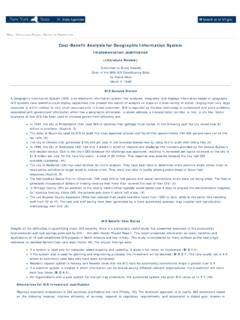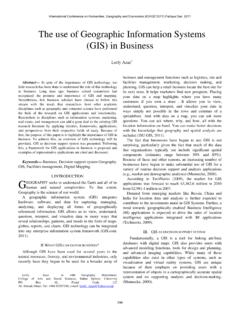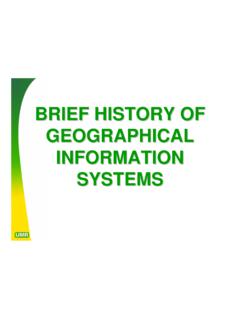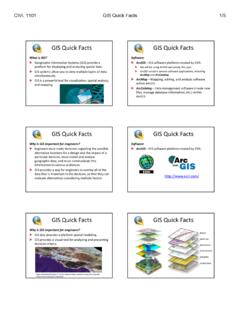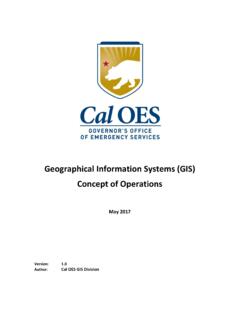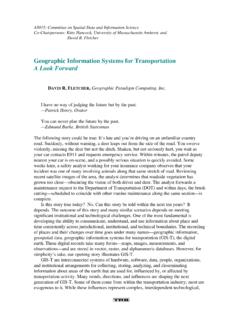Transcription of GEOGRAPHIC INFORMATION SYSTEMS (GIS) …
1 GEOGRAPHIC INFORMATION SYSTEMS (GIS) business PLAN:Washington Enterprise GIS Program and Shared Access to Geospatial ServicesFINAL: May 14, 2010120 Lakeside Avenue Suite 200 Seattle, Washington 98122 P (206) 324-8760 Helping Communities and Organizations Create Their Best Futures Principals: Bonnie Berk and Michael HodginsProject Manager: Natasha FedoProject Team: Bonnie Berk, Natasha Fedo, Julia WarthWashington State GEOGRAPHIC INFORMATION Council (WAGIC)Executive MembersIan Von Essen, Spokane CountyKerry Brooks, Washington State UniversityTom Carlson, US Geological SurveyAlan Smith, Department of TransportationTim Young, Department of Fish & WildlifeRon Holeman, Department of Natural ResourcesDan Miller, Washington Military DepartmentMatt Parsons, University of WashingtonMatthieu Denuelle, ESRIDan Saul, Department of EcologyGeorge Alvarado, Department of RevenueDavid Jennings, Department of HealthSteve Rush, HanfordMike Mohrman, Office of Financial ManagementTeresa Mathiesen, City of EllensburgPlan Primary Author:Joy Paulus, GIS CoordinatorStaff to the ISB-GIT and WAGICGIS Program OfficeDepartment of INFORMATION ServicesFor more I I INFORMATION SYSTEMS (GIS) business PLAN.
2 Washington Enterprise GIS Program and Shared Access to Geospatial Services GEOGRAPHIC INFORMATION SYSTEMS (GIS) business PLAN Washington Enterprise GIS Program and Shared Access to Geospatial Services: Design and Implementation EXECUTIVE SUMMARY This plan is an extension of the GEOGRAPHIC INFORMATION SYSTEMS Strategic Plan: Mapping Washington s Future, 2010 2014 completed under the 50 States Initiative s grant from the United States Geological Survey (USGS). This business Plan addresses two of the goals identified in the Strategic Plan, and details their implementation. These goals were identified by Washington GEOGRAPHIC INFORMATION Council (WAGIC) as the primary steps to achieving the Vision of the Strategic Plan and the most feasible in the current economic and political climate. Goal 1: Establish Access Mechanism for Washington Geospatial Data There is a significant need for a data discovery and access mechanism that is easy to use, well organized, searchable, consistently updated and capable of supporting both centralized and distributed resources.
3 Benefits of such a tool include the ability to easily find and share data, reduced data redundancy, and increased opportunities for inter governmental collaboration. Goal 2: Staff GIS Program Office and Recruit a State Geospatial INFORMATION Officer In order to implement the overarching strategic goals, it is necessary to fully staff the existing state GIS Program Office, and recruit a state Geospatial INFORMATION Officer (GIO). The GIO will coordinate interagency and intergovernmental efforts and will provide executive leadership for the state s GIS user community. Together, these goals best describe an enterprise GIS Program that will help agencies realize the Governor s objectives for creating more shared services in state government and GIS consolidation across agencies. The GIS business Plan lays the groundwork for the development of a federated organizational model to more effectively deploy GIS resources in the State of Washington.
4 Enterprise GIS Approach The GIS enterprise approach advances customer services by providing external entities access to desired INFORMATION , spatial data resources, standards, and web based services in an effort to support transparency in state government. The key enterprise program elements include: Formalize GIS Data Stewardship: Designate data steward(s) for each of the enterprise level GIS data sets and any data services consuming these data. Provide Shared GIS Infrastructure: Establish a single point of access for enterprise level data and shared services to reduce confusion and storage costs of hosting multiple copies of data. Provide access to services like address matching, visualization tools, and applications that public, private, and governmental entities can use and benefit from. Shared data will lead to better decisions as agencies work from official versions of data rather than multiple, unsynchronized, or inconsistent versions of data.
5 EXECUTIVE SUMMARY GEOGRPAHIC INFORMATION SYSTEMS (GIS) business PLAN Washington Enterprise GIS Program and Shared Access to Geospatial Services 5/14/2010 FINAL DRAFT ES 2 Expand Washington State GIS Program Office: Expand Washington State GIS Program Office and establish the state Geospatial INFORMATION Officer (GIO) to be responsible for running the shared infrastructure, coordinating GIS data and software purchases, managing business agreements between stakeholders, securing sustainable funding for the upkeep of the shared infrastructure, coordinating data acquisition, and serving as the GIS point of contact for external stakeholders. The GIO will interface and coordinate across all governmental entities and businesses at the executive level. Implementation Plan The business Plan embraces changes the GIS community has envisioned for years and recommended in the Washington s 2006 Enterprise Architecture effort.
6 The implementation of this Plan is separated into four phases: Phase I Budget Development and Return on Investment Planning Enterprise GIS Program: Create the budget decision packages needed to fund the phased development of the vision outlined in this Plan (staffing and infrastructure). Return on Investment Funding/Grant: Submit grant proposal to fund the development of an ROI analysis for common infrastructure geospatial data and value of shared services. Return on Investment (ROI): Plan for conducting a formal ROI analysis for Enterprise GIS implementation and need for geospatial data. Identify potential ROI funding opportunities; identify entity participation and commitments for involvement. Phase II Infrastructure and Technical Staff Implementation Infrastructure: Implement the infrastructure needed to support the access, discovery, storage and potential maintenance of common geospatial data, once funding is identified and procured.
7 Leverage and expand the existing orthoimagery portal infrastructure and add the hardware and software resources needed to support the enterprise environment for framework data and shared services. Technical Staffing: Develop job descriptions and recruiting plan for technical support staff. Begin hiring process for required and approved staffing. Shared Geospatial Services and Data: Position infrastructure and staff to provide shared geospatial services to a wide range of governmental entities and stakeholder clients. Phase III Enterprise GIS Office Expansion Staff GIS Program Office: Develop job description for GIO position; develop recruiting plan and hiring process for GIO; develop job descriptions and recruiting plan for technical support staff. Begin hiring process for required and approved staff. Phase IV Agency GIS Program Data Implementation Framework Data Sets: Provide the necessary support and funding needed to complete the active framework data efforts.
8 Shared Geospatial Services: Provide the necessary support and staffing needed to supply the shared geospatial services to the access and discovery portal. GEOGRAPHIC INFORMATION SYSTEMS (GIS) business PLAN Washington Enterprise GIS Program and Shared Access to Geospatial Services: Design and Implementation Contents GOALS AND business OBJECTIVES .. 1 Background .. 1 Selected Strategic Goals for business Implementation .. 2 BENEFITS AND business JUSTIFICATION .. 5 business Case for Enterprise GIS Approach for Washington .. 6 Benefits .. 7 REQUIREMENTS AND COSTS .. 9 Enterprise GIS Program Elements .. 9 Governmental Entities GIS Program Requirements and Costs .. 12 Risks to Successful Implementation .. 13 IMPLEMENTATION PLAN .. 14 MEASURING SUCCESS .. 18 APPENDIX A: List of Acronyms APPENDIX B: Core GIS Spatial Data Layers 5/14/2010 FINAL DRAFT 1 GEOGRAPHIC INFORMATION SYSTEMS (GIS) business PLAN Washington Enterprise GIS Program and Shared Access to Geospatial Services: Design and Implementation GOALS AND business OBJECTIVES Background This plan builds off the GEOGRAPHIC INFORMATION SYSTEMS (GIS)1 strategic planning effort that was completed in March 2010 under a 50 States Initiative s grant from the United States Geological Survey (USGS).
9 The resulting document titled GEOGRAPHIC INFORMATION SYSTEMS Strategic Plan: Mapping Washington s Future, 2010 2014 aligns with Washington s State INFORMATION Technology Strategic Plan (Exhibit 1). Using the GIS Strategic Plan as a foundation, this business Plan is designed to guide us to the delivery of more efficient and effective GIS enterprise solutions for Washington. Exhibit 1 Washington State INFORMATION Technology Strategic Plan Objectives Statewide GIS Coordination and Leadership The State of Washington has been making investments in GIS for approximately 30 years. Many of the investments have been made by the early adopter agencies like the Department of Transportation (DOT), the Department of Natural Resources (DNR), the Department of Fish and Wildlife (DFW) and Department of Ecology (ECY). Today many state agencies invest in GIS or are planning to do so. Despite its widespread use, no single organization is formally charged to provide executive coordination and oversight or provide enterprise infrastructure support for GIS on a statewide basis.
10 1 1 See Appendix A for a full List of Acronyms GEOGRPAHIC INFORMATION SYSTEMS (GIS) business PLAN Washington Enterprise GIS Program and Shared Access to Geospatial Services 5/14/2010 FINAL DRAFT 2 Starting with the formation of the Washington GIS Working Group (1984 85) and the subsequent establishment of the Washington GEOGRAPHIC INFORMATION Council (WAGIC, 1994), the GIS community has worked together to meet the needs of the user community in the state. Recently the INFORMATION Services Board s Committee on GEOGRAPHIC INFORMATION Technology (ISB GIT) has served as the de facto coordinator within state government. However, as the use of GIS continues to grow, personal working relationships within the WAGIC and the more formal ISB GIT processes are no longer sufficient to provide the level of coordination needed to maximize the potential benefits and increased efficiencies of GIS.




